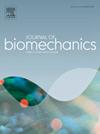Inverse kinematics in cervical spine models: Effects of scaling and model degrees of freedom for extension and flexion movements
Abstract
Intervertebral kinematics can affect model-predicted loads and strains in the spine; therefore knowledge of expected vertebral kinematics error is important for understanding the limitations of model predictions. This study addressed how different kinematic models of the neck affect the prediction of intervertebral kinematics from markers on the head and trunk. Eight subjects executed head and neck extension-flexion motion with simultaneous motion capture and biplanar dynamic stereo-radiography (DSX) of vertebrae C1-C7. A generic head and neck model in OpenSim was scaled by marker data, and three versions of the model were used with an inverse kinematics solver. The models differed according to the number of independent degrees of freedom (DOF) between the head and trunk: 3 rotational DOF with constraints defining intervertebral kinematics as a function of overall head-trunk motion; 24DOF with 3 independent rotational DOF at each level, skull-T1; 48DOF with 3 rotational and 3 translational DOF at each level. Marker tracking error was lower for scaled models compared to generic models and decreased as model DOF increased. The largest mean absolute error (MAE) was found in extension-flexion angle and anterior-posterior translation at C1-C2, and superior-inferior translation at C2-C3. Model scaling and complexity did not have a statistically significant effect on most error metrics when corrected for multiple comparisons, but ranges of motion were significantly different from DSX in some cases. This study evaluated model kinematics in comparison to gold standard radiographic data and provides important information about intervertebral kinematics error that are foundational to model validity.

 求助内容:
求助内容: 应助结果提醒方式:
应助结果提醒方式:


